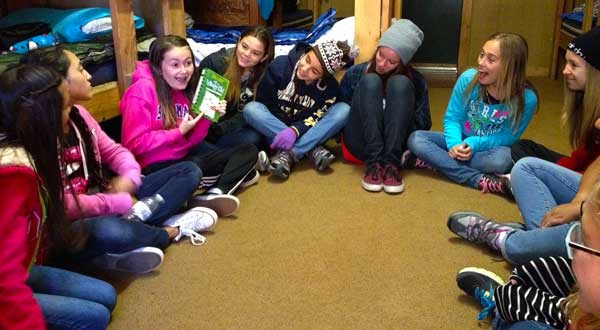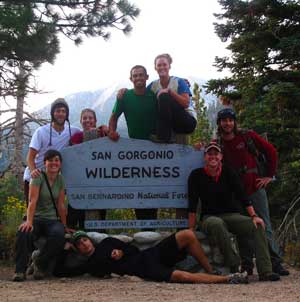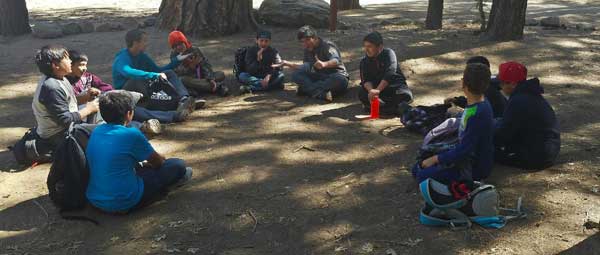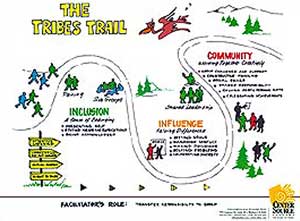“This needs to come from your heart,” I said in a soft tone.
I watched anxiously as 12 different sets of eyes peered back at me in puzzlement. I had asked my cabin group of sixth grade girls to turn to the person on their left and tell them something that they had recognized and appreciated about them throughout the week. For many, this might seem like quite a simple task, but when posed to a group of elementary school girls who are not always used to stepping outside of themselves and into their community, this can seem like an unusual and difficult undertaking.

 This type of community building activity falls under an evening class we at High Trails call “Tribes.” To be honest, when I first began my quest into the world of Tribes, I thought that this practice was unique to the “camp” environment. However, after researching the topic, I found that Tribes activities are being used around the globe to help students learn from one another in both classroom and camp environments.
This type of community building activity falls under an evening class we at High Trails call “Tribes.” To be honest, when I first began my quest into the world of Tribes, I thought that this practice was unique to the “camp” environment. However, after researching the topic, I found that Tribes activities are being used around the globe to help students learn from one another in both classroom and camp environments.
According to Ron Patrick, author of the article “Why The Name ‘Tribes’”, the word came into use due to a deep respect for the teachings and wisdom of native cultures around the world, as well as the name for the developmental learning process developed by Jeanne Gibbs. 1 Patrick goes on to state that the process known as “Tribes” helps us to create a sense of belonging for children in schools and other organizations.
In addition, it helps us, as educators, to teach the deep values of respect, responsibility, and relationship skills. As a cabin instructor, it is our job to facilitate activities and discussions among our students that portray the benefits that forming a community can have on their lives as well as the cabin group as a whole.
What are some Tribes activities? Well, it starts with a circle. Forming a circle as a group creates a sense of safety and togetherness that also allows for everyone to be on the same level with the ability to make eye contact with another. The activity can range from lighthearted to deep and serious, depending on the needs of your group. A group art project, a philosophical question posed to each member, or a simple game like “two truths and a lie” are all examples of Tribes activities.
Each activity is intended to bring out a unique result that can then be debriefed at the end in order to bond, grow, and learn something new as a group.
 Instructors can also foster this type of camaraderie simply by pulling from examples of our own community. Many of us are drawn to High Trails because of our craving for the fulfillment we feel when we belong to a group of like-minded individuals. This feeling of acceptance, belonging, and responsibility is something we can show our students through role modeling as well as what we personally bring to “Tribes” time.
Instructors can also foster this type of camaraderie simply by pulling from examples of our own community. Many of us are drawn to High Trails because of our craving for the fulfillment we feel when we belong to a group of like-minded individuals. This feeling of acceptance, belonging, and responsibility is something we can show our students through role modeling as well as what we personally bring to “Tribes” time.
I am constantly learning new things from my own community members. Whether it be rock climbing tricks, teaching techniques, or scientific facts, there will always be something that I can appreciate and gain from my peers. Knowing this about myself has taught me that Tribes is a great opportunity to have students teach one another a new skill, share their own accomplishments and what they are proud of, and bond together as a result.

A Kid Community?
 Throughout the week we can see the benefits of a “kid community” play out in different facets of camp. Whether it is seen in something small, such as helping one another get ready in the morning, or bigger, like overcoming a group conflict, when a connection is made the difference can be seen. In reference to the research done by the Tribes Learning Community, Tribes TLC states that this process enables students to feel included and appreciated by both peers and teachers and helps them feel respected for their differences. 2 Not to mention… it’s a great perk when they bond together to clean up after themselves in the cabin.
Throughout the week we can see the benefits of a “kid community” play out in different facets of camp. Whether it is seen in something small, such as helping one another get ready in the morning, or bigger, like overcoming a group conflict, when a connection is made the difference can be seen. In reference to the research done by the Tribes Learning Community, Tribes TLC states that this process enables students to feel included and appreciated by both peers and teachers and helps them feel respected for their differences. 2 Not to mention… it’s a great perk when they bond together to clean up after themselves in the cabin.
This is only the beginning. The sense of community that we are able to create here at High Trails through Tribes has the potential to grow and develop into each student’s home, school, peer group and more. As an instructor, I hope to not only instill an appreciation for nature and science, but the same appreciation for connection that I have learned through my own community.
“Every school should be a model home, a complete community actively developing future compassionate citizens capable of creating, leading and contributing to the kind of democratic communities – in which we all long to live.”
— Jeanne Gibbs
At High Trails Outdoor Science School, we literally force our instructors to write about elementary outdoor education, teaching outside, learning outside, our dirty classroom (the forest…gosh), environmental science, outdoor science, and all other tree hugging student and kid loving things that keep us engaged, passionate, driven, loving our job, digging our life, and spreading the word to anyone whose attention we can hold for long enough to actually make it through reading this entire sentence. Whew…. www.dirtyclassroom.com

Comments are closed.